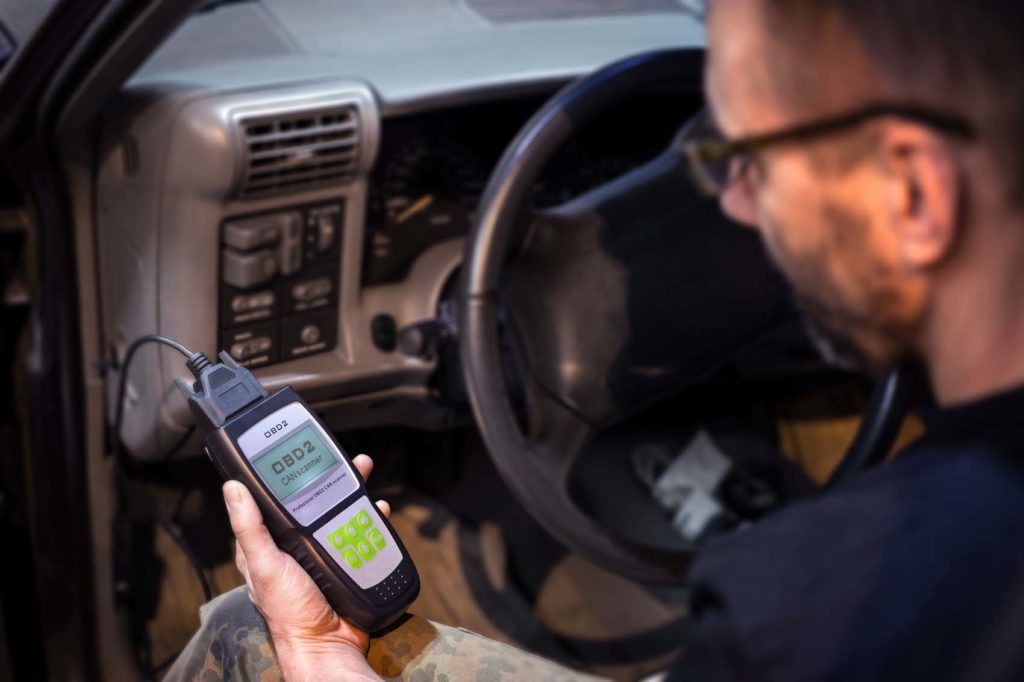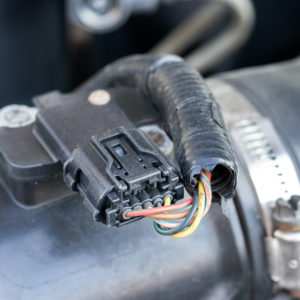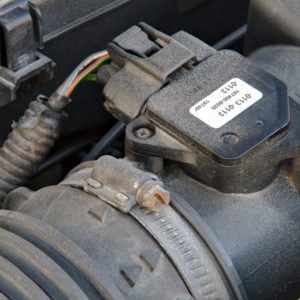Your vehicle is equipped with various sensors that are crucial to its operation. A mass air flow (MAF) sensor, for example, is one of the key components of the engine’s fuel injection system. It measures the amount of air entering the engine so that the powertrain control module (PCM) would know how much fuel is needed by the engine.
P0104 is an engine trouble code related to a possible issue in your vehicle’s MAF sensor circuit. The information below might help you understand this code better.
What Does the P0104 Code Mean?
Diagnostic trouble code (DTC) P0104 stands for “Mass Air Flow (MAF) “A” Circuit Intermittent/Erratic.” It may be logged once the PCM perceives that the MAF sensor frequency signal is not within the expected range based on the calculated MAF value.
This sensor is usually installed in the engine air intake tract downstream from the air filter. It measures the amount of air entering the engine by calculating its volume and density. A MAF sensor only measures a portion of intake air and uses this value to estimate the total volume and density of air entering your engine.
The data is sent to the PCM through a voltage or hertz signal. Once the PCM perceives an erratic voltage output from the MAF sensor circuit, it will trigger the code.
P0104 is similar to other MAF circuit trouble codes, such as P0100, P0101, P0102, and P0103.

It’s important to note that there is a certain window the ECM/PCM will accept as normal. If the signal coming from the MAF sensor drops below that acceptable window, a code is set. The code is different from one manufacturer to the next, so you may get a different code on your vehicle that means the same thing this code does.
Make sure you have a thorough understanding of mass air flow before proceeding with any DIY diagnosis or repair of your vehicle.
Note: The definition of code P0104 may be different depending on the vehicle manufacturer. Consult the appropriate repair manual or repair database for the exact code definition.
What are the Possible Causes of the P0104 Code?
Here are the possible triggers of the P0104 code:
- Failed/dirty MAF sensor
- Intake air leaks
- MAF sensor wiring/harness issues
- Issues with the PCM, such as software in need of an update

What are the Common Symptoms of a P0104 Code?
The symptoms of code P0104 may include the following:
- Illuminated check engine light
- Engine stalling
- Hard starting
- Rough running engine
- Black smoke from tailpipe
- Lack of acceleration
You may also experience other drivability symptoms due to this trouble code. However, in some cases, your vehicle may not exhibit any symptoms at all.
How to Diagnose the P0104 Code
It’s tricky to diagnose a P0104 code. Engine misfire and oxygen sensor codes may also be logged together with this code, so it may be very challenging to diagnose the root cause of the problem.

If you’re not an experienced automotive DIYer, it is best to take your vehicle to an auto repair shop for proper diagnosis and repair. However, if you prefer to diagnose this code yourself, you may consult vehicle-specific repair manuals and/or online repair databases. These resources will contain the information you need to properly diagnose your vehicle.
How to Fix the P0104 Code
Although P0104 is a generic trouble code, there is no one solution that would work for all makes and models. Remember that modern cars are structured differently per manufacturer. Repair procedures for this code may vary depending on the vehicle. For instance, the confirmed fixes of a code P0104 on a Toyota may not work for a code P0104 on a Mercedes.
If you’d like to resolve the code yourself, it would be best to consult vehicle-specific repair manuals and/or subscribe to an online repair database. These resources contain specific instructions that can help you address vehicle issues like faulty sensors.
However, if you’re not well-versed in auto repair, you can always bring your vehicle to an auto repair shop for proper diagnosis and repair.
Where to Get a New MAF Sensor and MAF Connector
Before anything else, you should avoid driving until you fix whatever’s causing the P0104 code to set in your vehicle. Error codes all point to a bigger issue that can sometimes be costly to repair if ignored. In this case, a P0104 code is usually because of a faulty MAF sensor or damaged MAF sensor connectors. Luckily, you can easily get both products at CarParts.com with just a few clicks.
At CarParts.com, we offer a wide selection of high-quality MAF sensors and MAF sensor connectors that you can choose from. Providing you with a worry-free shopping experience is one of our top priorities. You can shop with confidence, thanks to our 60-day returns policy. In case you aren’t completely satisfied with your order, you can return your order within 60 days of purchase, and we’ll give you your money back.
Don’t wait until other parts of your vehicle act up before replacing defective parts. Check out our wide selection of mass air flow sensors and mass air flow sensor connectors at CarParts.com, and shop today!
Any information provided on this Website is for informational purposes only and is not intended to replace consultation with a professional mechanic. The accuracy and timeliness of the information may change from the time of publication.















